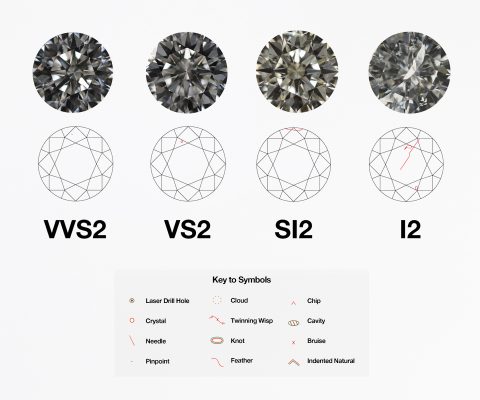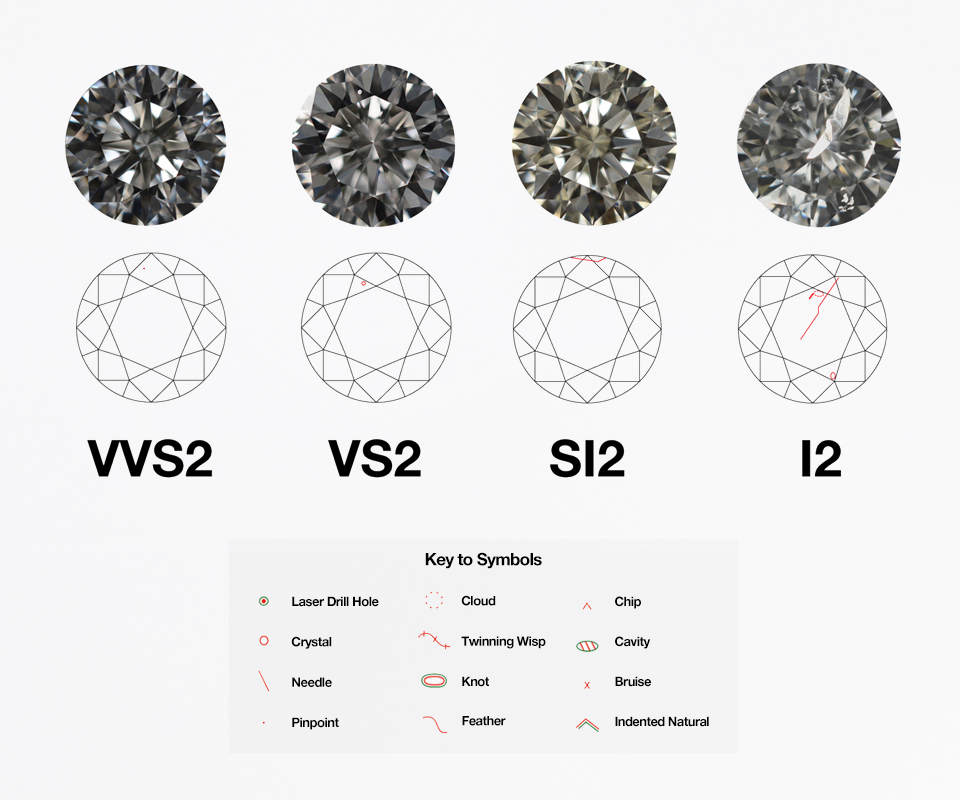Exploring diamonds? Clarity is a vital part of the 4 Cs! Certified Gem Knowledge is here to explain the GIA clarity scale, those tiny internal features called inclusions, and how they impact a diamond’s beauty and price. Let’s get clear on clarity.
Decoding the Diamond Clarity Grading Scale
When we talk about diamond clarity, we’re essentially discussing its purity. Think of it as a flawlessness level. How free is the diamond from tiny natural characteristics? Diamond clarity measures these internal and external flaws. Because these characteristics are natural results of a diamond’s formation deep within the earth, truly flawless diamonds are exceptionally rare. Indeed, flawless diamonds are extremely rare.
To create a universal standard, the Gemological Institute of America (GIA) established the Clarity Scale. This is the system used worldwide. The GIA scale grades diamond clarity, ensuring everyone uses the same language. The GIA Clarity Scale has a range from FL (Flawless) down to I3 (Included). Understanding this scale is crucial for making an informed choice. Generally, higher clarity grades mean fewer flaws, while lower clarity grades mean more obvious flaws.
Understanding Each Grade: From Flawless to Included
Let’s break down the diamond purity grade categories:

- Flawless (FL): An FL Diamond shows no inclusions or blemishes visible under 10x magnification. It’s the absolute top grade.
- Internally Flawless (IF): An IF Diamond has no inclusions visible under 10x magnification, but blemishes might be visible (minor ones). Still incredibly rare and valuable.
- Very Very Slightly Included (VVS1, VVS2): A VVS Diamond has minute inclusions that are difficult for even a skilled grader to see under 10x magnification. These diamonds appear perfectly clean to the naked eye.
- Very Slightly Included (VS1, VS2): A VS Diamond has minor inclusions that are somewhat easier to see under 10x magnification than VVS, but still typically invisible without aid.
- Slightly Included (SI1, SI2): An SI Diamond has noticeable inclusions visible under 10x magnification. Depending on the type and location, SI diamonds can sometimes be eye-clean.
- Included (I1, I2, I3): An I Diamond has obvious inclusions visible under 10x magnification, and these may often be seen without magnification. In some cases, they can affect the diamond’s transparency and sparkle.
Common Diamond Inclusions and Blemishes Explained
Diamonds form under immense heat and pressure. This natural diamond formation causes inclusions. These “birthmarks” make each diamond unique. It’s helpful to understand the difference:
- Inclusions are internal imperfections. An inclusion is an internal flaw.
- Blemishes are surface imperfections. A blemish is an external flaw.
Both inclusions affect the diamond clarity grade, and blemishes affect the diamond clarity grade too, though inclusions usually have a greater impact. Doing an internal characteristics assessment involves identifying these:
Internal Characteristics (Inclusions)
These are inside the diamond:
- Crystal: A mineral crystal (sometimes even a tiny diamond!) trapped inside.
- Feather: A small fracture within the diamond, named for its appearance.
- Cloud: A hazy area made of many microscopic pinpoints.
- Needle: A thin, elongated crystal.
- Pinpoint: A very tiny crystal that looks like a dot under magnification.
- Twinning Wisp: A series of pinpoints, clouds, or crystals formed during irregular growth.
- Knot: An included crystal that reaches the diamond’s surface.
External Characteristics (Blemishes)
These are on the diamond’s surface:
- Scratches: Lines caused by contact with other objects.
- Nicks: Small chips, often on facet edges.
- Pits: Tiny openings resembling white dots.
- Polish Marks: Fine lines left from the polishing process.
- Naturals: Small parts of the original rough diamond’s surface left unpolished on the girdle.
- Abrasions: Scuffed areas along facet junctions.
Understanding these helps in surface flaw grading perception. The diamond formation process creates inclusions naturally.
How Diamond Clarity is Professionally Graded
Grading clarity isn’t guesswork. It’s a meticulous clarity evaluation performed by a trained gemologist in a gemological laboratory. Gemologists assess clarity characteristics using strict standards.
The key tool? 10x magnification. Diamond clarity is assessed with 10x magnification. This is the global standard; flaws invisible at this power don’t affect the grade. The magnification standard has a power of 10x, and magnification is used to grade clarity.
The Five Factors Determining the Grade
Grading considers five clarity factors:
- Size: How large are the characteristics? Larger flaws generally mean a lower grade. The size of an inclusion influences the clarity grade. This is a key clarity grading factor aspect.
- Number: How many flaws are present? The number of inclusions influences the clarity grade. It’s more about how easily they’re seen, not just a simple count. This is another clarity grading factor aspect.
- Position: Where are the flaws located? An inclusion under the center (table) is more visible than one near the edge (girdle). The position of an inclusion influences visibility. This is a critical clarity grading factor aspect.
- Nature: What type of flaw is it? The nature of an inclusion determines if it’s internal/external. Is it a crystal, a feather, a surface nick? This is a crucial clarity grading factor aspect.
- Relief/Color: How much does the flaw contrast with the diamond? Darker inclusions are usually easier to see. The relief of an inclusion affects contrast. This is the final clarity grading factor aspect.
Clarity grading uses 10x magnification as the benchmark.
The Role of 10x Magnification and Grading Reports
That 10x magnification standard is non-negotiable for official grading. Grading reports often include a clarity plot, which maps inclusions. Think of it like a fingerprint – clarity plots map diamond ‘fingerprints’, showing the location and type of significant characteristics. Clarity characteristics define diamond uniqueness. This gemstone inclusion rating is vital.
The Impact of Clarity on Diamond Value and Appearance
Clarity significantly influences a diamond’s desirability and cost. The clarity grade impacts diamond value directly – the fewer and less obvious the flaws, the rarer and more expensive the diamond. Clarity impacts diamond price significantly.
Appearance is also affected. While clarity affects light reflection and brilliance, major inclusions can potentially block light, reducing sparkle. This is a key diamond appearance effect. Tiny flaws usually have no visual impact without magnification, but large ones can. This is why clarity is a major diamond value impact driver and influences the diamond sparkle factor.
In lower grades like I (Included), some inclusions can affect durability. An Included Diamond (I Grade) might have a potential impact on durability, especially if a large feather reaches the surface, creating a potential diamond durability risk.
Finding the Best Value: The Concept of ‘Eye-Clean’ Diamonds
Most people want a diamond that looks clean to the naked eye. This brings us to the idea of an eye-clean diamond. Eye-clean means flaws are invisible to the naked eye. An eye-clean diamond has no inclusions visible to the naked eye.
This is where value comes in! You don’t necessarily need a Flawless diamond for stunning beauty. Grades like VS (Very Slightly Included) and SI (Slightly Included) often provide the best bang for your buck. VS and SI grades offer good value because SI grades can be eye-clean, especially in smaller diamonds or brilliant cuts. The VS/SI grades are a common category for value seekers.
Why? The diamond cut plays a role! A well-cut diamond’s sparkle can cleverly hide minor inclusions. Diamond cut can hide inclusions. Brilliant cuts mask inclusions better than step cuts (like Emerald or Asscher), which reveal inclusions more due to their large, open facets. So, consider the cut and shape when choosing your clarity grade. It’s all about balancing clarity with diamond color and carat weight to find the perfect diamond imperfection measure for your engagement ring setting or other jewelry.
Understanding diamond clarity helps you appreciate a diamond’s uniqueness and make smart choices. We hope this guide from Certified Gem Knowledge clarifies things!


